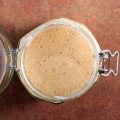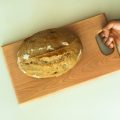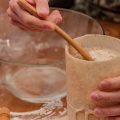Dehydrating your sourdough starter is probably one of the most efficient ways of storing your sourdough starter without fear of it spoiling. But once you’ve dehydrated the starter, how does one reactivate it? Well here’s everything you need to know about dehydrating and rehydrating your starter.
![How To Reactivate Dehydrated Sourdough Starter [Your Easy Guide!] 1 How to reactivate dehydrated sourdough starter](https://www.mydailysourdoughbread.com/wp-content/uploads/2023/01/CD-blog-images-2023-01-05T220412.696-720x405.jpg)
Table of Contents
- What is a Dehydrated Sourdough Starter?
- Benefits of Dried Sourdough Starter
- What Do You Need to Make a Dry Starter?
- Ways to Dry Out Sourdough Starter
- Making a Dehydrated Sourdough Starter
- How to Reactivate a Dehydrated Starter?
- How to Store Sourdough Starter for Longer?
- Dehydrated Sourdough Starters
- FAQs
What is a Dehydrated Sourdough Starter?
A dry or dehydrated starter is a mature sourdough starter that has been dried out and broken into pieces or stored in powder form. The good bacteria and yeasts remain within the dry sourdough starter, and with a little flour and water you can reactivate them.
By dehydrating the moisture from the starter you are putting a pause on the existing colonies of yeast and bacteria. It is much easier to store, and transport a dried sourdough starter.
When you’re ready to rehydrate or activate your starter, simply add fresh flour and water to the crisp starter.
What is a Sourdough Starter?
A sourdough starter is a live culture consisting of wild yeasts and bacteria that thrive in a mixture of flour and water. The sourdough starter acts as a leavening agent for sourdough bread baking. The wild yeasts help the dough rise, and the bacteria provide a sour or acidic flavor to the naturally-leavened bread.
To make good sourdough bread, you must take good care of your sourdough starter, and remember to feed it regularly.
Benefits of Dried Sourdough Starter
Dehydrating sourdough starter is super beneficial as it ensures that your starter is available whenever required, enabling you to take a break and come back to it once you’re ready to bake again. You won’t find yourself worrying about your starter drying when you have a dried starter!
Here are some more benefits of a dry starter:
- You won’t have to worry about mold or bacteria growing on your starter.
- If your wet starter becomes infected by mold, you don’t have to start all over again, just reactivate the dried starter.
- You don’t have to keep a portion of the starter in the refrigerator, free up some space!
- You can post your starter through the mail.
- You can easily travel with your sourdough starter.
![How To Reactivate Dehydrated Sourdough Starter [Your Easy Guide!] 2 How to reactivate dehydrated sourdough starter](https://www.mydailysourdoughbread.com/wp-content/uploads/2023/01/CD-blog-images-2023-01-05T215012.106-720x405.jpg)
What Do You Need to Make a Dry Starter?
You’ll need an active and well-fed sourdough starter. Your starter must also be mature, as the microflora within the mature starter are sturdier and have developed resistance with time. The yeasts and bacteria are also resistant to unpleasant environments, so it’s best to dehydrate a 5-6 month old starter.
To dehydrate sourdough starter you’ll need:
- A large baking tray for drying your sourdough starter. Choose a large tray so that you can thinly spread the sourdough starter, enabling it to dry faster.
- A silicone mat or parchment paper to spread the starter so that it can easily separate from it after drying.
- A spatula to spread the starter in a thin layer
- An airtight jar to store the dehydrated starter, whether it is in powder form or flakes. You can also store it in a zip-lock packet.
Ways to Dry Out Sourdough Starter
Some of the ways to dry out an active starter are as follows:
- Air drying: This is the simplest way to dry a sourdough starter. Simply spread the starter on parchment paper and let it air dry for 24-48 hours.
- Pressed between two papers: Spread the starter on a parchment sheet then place another parchment sheet over it. Gently press down two to remove any air bubbles, then let them dry for 24-48 hours. You should be able to easily peel the top piece of parchment paper away to reveal the dried starter.
- Drying under a fan or air conditioner: Drying sourdough starter under a fan or air conditioner can effectively speed up the process. Simply spread the starter under a fan or AC.
- A dehydrator: Choose the lowest temperature setting of the dehydrator, and keep the temperature at 95 degrees Fahrenheit.
Making a Dehydrated Sourdough Starter
Here’s how to make your very own dehydrated sourdough starter:
Ensure the Starter is Ripe
Before you begin to dehydrate the starter it is important to ensure that your starter is ripe.
A starter is ripe when it is at its peak of microbial activity i.e, maximum rise. This usually occurs within 3-4 hours of feeding. Another indicator that your starter is ripe, is with its domed-shaped top.
If you dehydrate an unfed sourdough starter, then reviving it is going to be difficult. Which is why it’s very important to make sure that your starter is at least 5-6 months old.
Prepare a Tray
Choose the largest tray in the kitchen, so that you have a large surface area to work with. It also enables you to spread your starter thinner so that it dries faster.
The best way to do this is by adding parchment paper to your baking sheet and sticking the paper down with some tape. This way the paper won’t bunch together when spreading your starter.
Spread the Starter on Parchment Paper
Empty the starter one one side of the parchment paper and spread it towards the other side using an offset spatula or a silicone spatula. Make sure you spread the starter evenly and thinly so that it can dry faster.
Dry the Starter
Place the tray in a cool and well-ventilated part of the kitchen. Within a day or two it should become dry like a chip. The dried sourdough starter chips will break apart easily. Ensure that there are no wet spots of starter on the parchment paper.
Store the Dried Starter
Dehydrated sourdough starter is super easy to store. You can break it apart and store it like chips, or pulse it in the food processor to make a powdered dry sourdough starter. Make sure that you store dehydrated sourdough starter in an airtight container or ziplock bag for as long as needed.
![How To Reactivate Dehydrated Sourdough Starter [Your Easy Guide!] 3 How to reactivate dehydrated sourdough starter](https://www.mydailysourdoughbread.com/wp-content/uploads/2023/01/CD-blog-images-2023-01-05T214923.318-720x405.jpg)
How to Reactivate a Dehydrated Starter?
Now that you’ve learnt how to dehydrate a starter, it’s time to discover how to revive a dried sourdough starter.
Weigh the Dry Starter
It’s best to start with a small amount. You can start with 10g, if you’re using dehydrated starter chips, then crush them into a fine powder before using them.
Rehydrate Sourdough Starter
Place the dried starter in a glass jar with a lid. Then use equal parts warm water and flour (15g). Cover the jar and let it rest on the kitchen counter for 3-4 hours. You should notice a few tiny bubbles appear on the surface. The purpose of rehydrating sourdough starter is to encourage yeast activity.
Feeding 1
Now it’s time to feed the starter for baking sourdough bread. Start with 30g of whole wheat flour, or all purpose flour, and 30g of water. Make sure you’re using chlorinated water, or bottled water. Then cover and let the starter rest in a warm spot for 12-14 hours or overnight. You should be able to see some activity in the dehydrated starter, meaning that it’s on its way to recovery.
Feeding 2
The next morning discard 45g of starter and feed it with 45g of whole wheat flour and 45g of water. Mix and let this rest on the kitchen counter for 6-7 hours.
Feeding 3
Discard 65g of starter and feed it with 65g of flour and water. You should be able to see your starter coming back to life slowly, and reacting to each feed normally. The morning after that you can use your rehydrated starter to bake bread.
How to Store Sourdough Starter for Longer?
There are many ways to store your starter for longer periods.
Firstly, you can refrigerate the starter. A mature starter can be stored in the refrigerator for up to a month without feeding. Simply place it in a larger jar with lots of empty space, and place it in the back of the fridge on the top shelf.
Did you know that you could freeze sourdough starter? In fact, you can leave your starter frozen for years. While some believe that the microbes could die while frozen, it’s better to freeze a weak mature starter.
Lastly, drying sourdough starter. Drying sourdough starter is probably one of the most common methods of storing the starter for longer. When you dehydrate sourdough starter it will retain the live culture of yeasts and bacteria, effectively preserving it indefinitely.
Dehydrated Sourdough Starters
Dehydrated sourdough starters make the perfect storage option for those who want to take a break from sourdough baking. Ensure that your starter is completely dry before storing it in an airtight container, and in a cool place, ready for you to use for your future sourdough bread recipes.
FAQs
Is Dehydrated Sourdough Starter Good?
Yes. In fact, dehydrating your sourdough starter is an incredible way to preserve it and save it for future bakes.
Can Sourdough Starter be Dehydrated?
Yes. A sourdough starter can definitely be dried or dehydrated.
How do You Revive a Dehydrated Sourdough Starter?
To revive a dehydrated sourdough starter, simply combine 5g of finely crumbled sourdough starter in a small glass jar. Add 25g of filtered water, stirring until the dry starter has completely submerged in water. Cover it with a lid and allow the mixture to sit for one hour at room temperature.
How Long is Dehydrated Sourdough Starter Good?
Indefinitely. Your dehydrated sourdough starter will last forever, as long as you keep it away from light, heat and moisture.





![Sourdough Starter Temperature [Beginner'S Guide] 8 Sourdough starter temperature [a beginner’s guide]](https://www.mydailysourdoughbread.com/wp-content/uploads/2023/01/blog-images-48-120x120.jpg)
